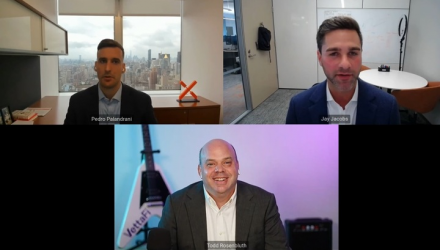Artificial intelligence is one of the top investment themes this year and is the new megatrend likely to last for at least the next decade. BlackRock’s Jay Jacobs and Global X’s Pedro Palandrani joined VettaFi’s head of research, Todd Rosenbluth, to discuss AI investing and companies to look to in the coming years at the recent AI Symposium hosted by VettaFi.
Jay Jacobs, U.S. head of thematics and active equity ETFs at BlackRock, kicked things off with why BlackRock views artificial intelligence as an integral investment theme. BlackRock maintains the position that AI is one of the most powerful forces in terms of economic impact, looking ahead.
“We believe that this is going to be one of the most transformational technologies really since the introduction of the internet,” explained Jacobs. “If you look at artificial intelligence as a whole, this is probably a $15 trillion economy within AI, with probably $25 trillion worth of economic impact.”
The adoption of artificial intelligence is already happening at a rapid pace. ChatGPT logged more than 100 billion new users in the last two months. Jacobs also remarked that AI is crossing its inflection point on the j-curve of adoption.
Attendees agreed, with 53% of survey respondents indicating they believe AI is the biggest thing since the internet.
A Multi-Decade Megatrend in the Making
Pedro Palandrani, VP, director of research at Global X, explained that Global X is of the mindset that artificial intelligence will remain a thematic investment for up to the next 15 years.
“It is in my view that by the end of the decade, we’re going to have two types of companies,” Palandrani said. These include companies utilizing AI within their business model and across their products and offerings, and then those that cease to exist because they didn’t grow to incorporate AI in some manner.
“I truly believe that every single company is going to have to leverage artificial intelligence,” explained Palandrani.
Global X approaches the growth of AI as a three-phase process. The first phase, which we are currently in, relies heavily on hardware companies and hardware evolutions to allow efficient scaling. Companies like NVIDIA are integral drivers in the first phase.
The second phase focuses on data management and Palandrani explained we are in the beginning parts of this phase. This includes the buildout of the infrastructure for artificial intelligence via the cloud. Major companies that Palandrani coins “hyper scalers” in this arena include Microsoft and Amazon, and are likely to remain the core infrastructure players looking ahead.
“The third phase, which is probably where we see the most attractive investment opportunity moving ahead is what we call the interface,” Palandrani said. These companies are the ones responsible for how consumers interact with and use AI in their daily lives.
AI Investing Opportunities Long-Term
Jacobs believes the direct beneficiaries of artificial intelligence currently are hardware companies, and AI platform developers.
“Where I think this gets more interesting is when we look three to five years out, when we really see more adoption and integration of AI into the economy,” Jacobs said. The will be a number of industries that benefit from the AI disruption, and a number of industries hurt by it.
Healthcare is a prime industry that artificial intelligence will revolutionize and disrupt in positive ways. Medicine in particular, and genomics companies, are ones that BlackRock is looking to as outsized beneficiaries of AI adoption. General software companies also stand to benefit from generative AI in regard to handling customer requests and development.
For advisors on the fence about targeted AI investing, Jacobs explained that the average advisor’s equity portfolio carries about a 20% exposure to artificial intelligence already. “That is a huge allocation, but if you look under the hood at how they’re getting that exposure, it is very much large cap tech stocks.”
“We want to make sure advisors are not doubling down on those mega-cap names,” Jacobs said. The iShares Robotics and Artificial Intel Multisector ETF (IRBO) is equal weighted and a long-term play on artificial intelligence that invests across the AI ecosystem. The fund targets small- and mid-cap companies that are the next generation of leaders in AI, as well as some of the players today.
For a different approach to the space, the Global X Artificial Intelligence & Technology ETF (AIQ) focuses on the mega-cap companies employing AI in their business models. Meanwhile, the Global X Cloud Computing ETF (CLOU) focuses on the companies that currently have generative AI offerings and features. Both funds focus primarily on the interface phase of AI adoption and are more forward-looking.
AI Investing Opportunities for the Short- to Mid-Term
Advisors seeking a concentrated, pure-play strategy in the space should look to the Global X Robotics and Artificial Intelligence ETF (BOTZ). The fund captures four different verticals within robotics and artificial intelligence. These include industrial robotics, non-industrial robotics, AI companies that includes both hardware and software, and autonomous vehicles and automation.
The iShares Semiconductor ETF (SOXX) is a shorter-term play due to the AI-driven demand for semiconductors. The chips in high-demand now will likely not the same types of chips necessary in the future. Current supply chain constraints make SOXX a particularly appealing fund for right now.
“Just because we’re seeing an explosion of AI interest today does not mean that the theme is going to play out over the short-term,” Jacobs explained. “I think this is an incredibly powerful theme. It’s incredibly nuanced, which is going to impact many different parts of the economy over the coming years.”
To view this session and others from the AI Symposium, register for the on-demand replay.
For more news, information, and strategy, visit the Artificial Intelligence Channel.

